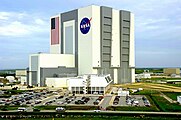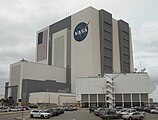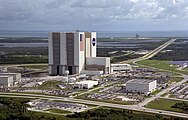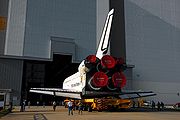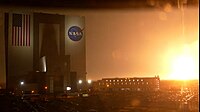Vehicle Assembly Building
| Vehicle Assembly Building | |
|---|---|
 | |
| Former names | Vertical Assembly Building |
| General information | |
| Type | Integration facility |
| Town or city | Brevard County, Florida |
| Country | United States |
| Coordinates | 28°35′11″N80°39′5″W/ 28.58639°N 80.65139°W |
| Completed | 1966 |
| Owner | NASA |
| Height | 526 ft (160 m) |
| Dimensions | |
| Diameter | 716 ft × 518 ft (218 m × 158 m) |
| Technical details | |
| Floor count | 1 |
| Floor area | 8 acres (32,000 m2) |
| Design and construction | |
| Main contractor | Morrison-Knudsen |
Vehicle Assembly Building | |
| Location | Kennedy Space CenterFlorida,U.S. |
| Nearest city | Titusville |
| Area | 8 acres (3 ha) |
| Built | 1966 |
| Architect | https:// urbahn |
| Architectural style | Industrial |
| MPS | John F. Kennedy Space Center MPS |
| NRHP referenceNo. | 99001642[1] |
| Added to NRHP | January 21, 2000 |
TheVehicle Assembly Building(originally theVertical Assembly Building), orVAB,is a large building atNASA'sKennedy Space Center(KSC) in Florida, designed to assemble large pre-manufactured space vehicle components, such as the massiveSaturn V,theSpace Shuttleand theSpace Launch System,andstackthem vertically onto one of threemobile launcher platformsused by NASA. As of March 2022, the firstSpace Launch System(SLS) rocket was assembled inside in preparation for theArtemis 1mission,[2]launched on November 16, 2022.
At 129,428,000 cu ft (3,665,000 m3), it is theeighth-largest building in the worldby volume as of 2022.[3]The building is atLaunch Complex 39at KSC, 149 miles (240 km) south ofJacksonville,219 miles (352 km) north ofMiami,and 50 miles (80 km) due east ofOrlando,onMerritt Islandon theAtlanticcoastofFlorida.[3]
The VAB is the largest single-story building in the world,[4]was the tallest building (526 ft or 160 m) in Florida until 1974,[5]and is the tallest building in the United States outside an urban area.[6]
History[edit]
The VAB, completed in 1966, was originally built for the vertical assembly of theApollo–Saturn Vspace vehicleand was originally referred to as theVertical Assembly Building.In anticipation of post-Apollo projects such as theSpace Shuttleprogram, it was renamed the Vehicle Assembly Building on February 3, 1965.[7][8]It was subsequently used to mate the Space Shuttleorbitersto theirexternal fuel tanksandsolid rocket boosters.Once the complete space vehicle was assembled on amobile launcher platform,acrawler-transportermoved it toLaunch Complex-39Aor39B.
Before the destruction ofSpace ShuttleColumbiain 2003, NASA installed a sub-roof inside the VAB to deal with falling concrete debris due to the building's age.[9]
The VAB was designated as aNational Historic Civil Engineering Landmarkby theAmerican Society of Civil Engineersin 2020.[10]
Construction[edit]
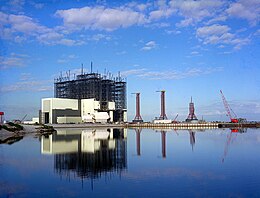
In 1963, NASA contracted Urbahn Architects to design and build the VAB. Construction began with driving the first steel foundation piles on Aug. 2, 1963. It was part of NASA's massive effort to send astronauts to the Moon for theApollo program.Altogether, 4,225 pilings were driven down 164 feet to bedrock with a foundation consisting of 30,000 cubic yards (23,000 m3) of concrete. Construction of the VAB required 98,590 short tons (197,180,000 lb; 89,440,000 kg) of steel.[11]The building was completed in 1966.[12]The VAB is 526 feet (160.3 m) tall, 716 feet (218.2 m) long and 518 feet (157.9 m) wide. It covers 8 acres (32,000 m2), and encloses 129,428,000 cubic feet (3,665,000 m3) of space.[13]Located on Florida's Atlantic coast, the building was constructed to withstandhurricanesandtropical storms.Despite this, it has received damage from several hurricanes (seebelow).
Capabilities[edit]
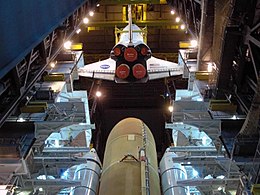
There are four entries to the bays located inside the building, which are the four largest doors in the world.[12]Each door is 456 feet (139.0 m) high, has seven vertical panels and four horizontal panels, and takes 45 minutes to completely open or close. The north entry that leads to the transfer aisle was widened by 40 feet (12.2 m) to allow entry of the shuttle orbiter. A central slot at the north entry allowed for passage of the orbiter's vertical stabilizer.
To lift the components of the Space Shuttle, the VAB housed five overhead bridgecranes,including two capable of lifting 325 tons, and 136 other lifting devices.
The building hasair conditioningequipment, including 125 ventilators[3]on the roof supported by four large air handlers (four cylindrical structures west of the building) rated at a total 10,000tons of refrigeration(120,000,000BTU/hr,35 MW) to keep moisture under control. Air in the building can be completely replaced every hour. The large doors can allow fog to roll into the building and become trapped, leading to incorrect rumors that the building has its ownweatherand can form clouds.[14]
Exterior[edit]
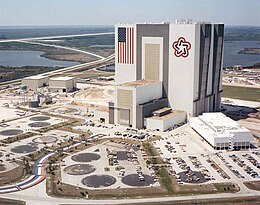
TheAmerican flagpainted on the building was the largest in the world when added in 1976 as part ofUnited States Bicentennialcelebrations, along with the star logo of the anniversary, later replaced by theNASA insigniain 1998. It is 209 feet (63.7 m) high and 110 feet (33.5 m) wide. Each of the stars on the flag is 6 feet (1.83 m) across, the blue field is the size of a regulation basketball court, and each of the stripes is 9 feet (2.74 m) wide.[15] Work began in early 2007 to restore the exterior paint on the immense facility. Special attention was paid to the enormous American flag and NASA "meatball" insignia. The work repaired visible damage from years of storms and weathering. The flag and logo had been previously repainted in 1998 for NASA's 40th anniversary.[16]
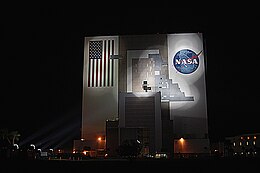
The most extensive exterior damage occurred during the storm season of 2004, whenHurricane Francesblew off 850 14-by-6-foot (4.3 m × 1.8 m)aluminumpanels from the building, resulting in about 40,000 square feet (3,700 m2) of new openings in the sides.[16][17]Twenty-five additional panels were blown off the east side by the winds fromHurricane Jeannejust three weeks later. Earlier in the season,Hurricane Charleycaused significant but less serious damage, estimated to cost $700,000 to repair. Damage caused by these hurricanes was still visible in 2007. Some of these panels are "punch-outs", designed to detach from the VAB when a large pressure differential is created on the outside vs. the inside. This allows for equalization, and helps protect the structural integrity of the building during rapid changes in pressure such as in tropical cyclones.
The building has been used as a backdrop in several Hollywood movies includingMarooned,SpaceCamp,Apollo 13,Contact,and others.
Future[edit]
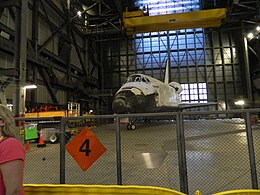
Originally, after the Space Shuttle was intended to be retired in 2010, the VAB would have been renovated for stacking of theAres IandAres Vlaunch vehicles for theConstellation program,however the Constellation program was cancelled in 2010. The Space Shuttle itself was retired in 2011 after which NASA temporarily (as early as 2012) offered public tours of the VAB. These tours were temporarily discontinued in February 2014 to allow for renovations to take place.[18]
The NASA FY2013 budget included US$143.7 million for Construction of Facilities (CoF) requirements in support of what is now known as theArtemis programand its vehicles, including theSpace Launch System(SLS) andOrion spacecraft.NASA began modifying Launch Complex 39 at KSC to support the new SLS in 2014, beginning with major repairs, code upgrades and safety improvements to the Launch Control Center, Vehicle Assembly Building (VAB) and the VAB Utility Annex. This initial work is required to support any launch vehicle operated from Launch Complex 39 and will allow NASA to begin modernizing the facilities, while vehicle-specific requirements are being developed.[19]
The VAB could be used to some extent for assembly and processing of any future vehicles using Launch Complex 39, in addition to renovations for SLS capabilities. On June 16, 2015, NASA released an announcement for proposals (AFP) seeking interest in using the VAB High Bay 2 and other complex facilities for commercial use in "assembling, integration, and testing of launch vehicles". This move is in line with the intent to migrate KSC towards acting as a spaceport accessible to both government and commercial ventures.[20]
On April 21, 2016, NASA announced the selection ofOrbital ATK(bought byNorthrop Grummanas of 2019) to begin negotiations for High Bay 2. The "potential agreement" included an existing mobile launcher platform.[21]NASA subsequently completed the agreement in August 2019 to lease High Bay 2 andMobile Launcher Platform3 to Northrop Grumman for use with theirOmegAlaunch vehicle.[22]However, development of OmegA was subsequently cancelled in September 2020. Northrop Grumman had yet to make any modifications to High Bay 2, and were using it for the storage of OmegA hardware. This hardware was scheduled to be removed from the VAB and returned to Northrop Grumman by the end of September 2020.[23]
Gallery[edit]
-
Aerial view of the Vehicle Assembly Building atKennedy Space Centerin 2011
-
The VAB in 2019
-
Overview of the VAB and LCC industrial area
-
The VAB as viewed from the nearby parking lot, 19 January 2022
-
Space Launch SystemArtemis 1rollout out of the VAB, 17 March 2022
-
VAB Beside theSLS Block 1Artemis 1during the Launch, 16 November 2022
References[edit]
- ^"National Register Information System – (#99001642)".National Register of Historic Places.National Park Service.July 9, 2010.
- ^Barker, Nathan; Gebhardt, Chris (March 17, 2022)."NASA moon rocket SLS rolls out to" rebuilt "LC-39B ahead of Artemis 1 rehearsal".NASASpaceFlight.Archivedfrom the original on November 16, 2022.RetrievedMarch 18,2022.
- ^abcNASA(1999)."Vehicle Assembly Building".NASA.Archived fromthe originalon December 29, 2017.RetrievedSeptember 23,2007.
- ^"Groundbreaking Digital Experience for Endeavour Shuttle Launch"(Press release). Redmond, Washington:Microsoft.August 5, 2007.Archivedfrom the original on November 29, 2023.RetrievedSeptember 23,2007.
- ^Taylor, George Lansing (September 20, 1988)."NASA Vehicle Assembly Building, Cape Canaveral, FL".UNF Digital Commons.University of North Florida.Archivedfrom the original on July 31, 2023.RetrievedJanuary 28,2023.
- ^Aguiar, Laura (January 10, 2020)."The Many Stories of the VAB"(PDF).Spaceport Magazine.Vol. 7, no. 1.NASA.Archived(PDF)from the original on February 19, 2024.RetrievedJanuary 28,2023.
- ^Benson, Charles Dunlap; Faherty, William Barnaby (1978). "VAB Nears Completion".Moonport: A History of Apollo Launch Facilities and Operations.NASA.SP-4204.Archivedfrom the original on October 25, 2023.RetrievedSeptember 25,2014.
The new name, it was felt, would more readily encompass future as well as current programs and would not be tied to the Saturn booster.
- ^"America's Spaceport"(PDF).NASA.2010. p. 13.Archived(PDF)from the original on February 19, 2024.RetrievedFebruary 22,2013.
- ^Gehman, Harold W.;Barry, John L.; Deal, Duane W.;Hallock, James N.;Hess, Kenneth W.;Hubbard, G. Scott;Logsdon, John M.;Osheroff, Douglas D.;Ride, Sally K.;Tetrault, Roger E.;Turcotte, Stephen A.;Wallace, Steven B.;Widnall, Sheila E.(August 2003).Columbia Accident Investigation Board, Report Vol. 1(PDF).p. 114.ISBN978-0-16-067904-9.Archived(PDF)from the original on September 18, 2023.
- ^"Vehicle Assembly Building at KSC Designated as National Civil Engineering Landmark".Florida Today.January 10, 2020.Archivedfrom the original on January 11, 2020.RetrievedAugust 20,2022.
- ^Granath, Bob (July 18, 2013)."Vehicle Assembly Building Prepared for Another 50 Years of Service"(Press release). Archived fromthe originalon September 29, 2016.RetrievedFebruary 4,2018.
- ^ab"Vehicle Assembly Building"(PDF).NASA.2012. FS-2012-06-121-KSC.Archived(PDF)from the original on February 3, 2024.
- ^Marquardt, Sarah (August 14, 2017)."An Exclusive Look Inside The Secretive Building Where NASA Makes Rockets".futurism.Archivedfrom the original on September 24, 2023.RetrievedJanuary 28,2023.
- ^Cardona, Carolina (July 3, 2019)."Inside the VAB at Kennedy Space Center".WKMG.Graham Media Group.Archivedfrom the original on January 27, 2023.RetrievedMarch 14,2021.
- ^Stuckey, Jeff (May 27, 2005)."Vehicle Assembly Building's American flag flies again"(PDF).Spaceport News.Vol. 44, no. 12.NASA.Archived(PDF)from the original on February 19, 2024.
- ^abMansfield, Cheryl L. (January 11, 2007)."Restoring Old Glory and a Massive Meatball".NASA.Archived fromthe originalon March 4, 2021.RetrievedJuly 11,2007.
- ^O'Brien, Miles (September 6, 2004)."Frances tears panels from NASA shuttle hangar".CNN.Archivedfrom the original on December 20, 2022.RetrievedSeptember 23,2007.
- ^Pearlman, Robert Z. (January 22, 2014)."Rocket Renovations Will End Public Tours of NASA's Vehicle Assembly Building".Space.Archivedfrom the original on December 8, 2023.
- ^"NASA FY13 Budget"(PDF).Archived fromthe original(PDF)on March 4, 2016.RetrievedJune 9,2012.
- ^Schierholz, Stephanie; Chevalier, Mary Ann, eds. (June 15, 2015)."NASA Solicits Proposals for Use of Kennedy Space Center's Vehicle Assembly Building High Bay 2"(Press release).NASA.Archivedfrom the original on February 19, 2024.
- ^Chevalier, Mary Ann, ed. (April 21, 2016)."NASA Selects Orbital ATK to Begin Negotiations for Space in Iconic Vehicle Assembly Building"(Press release).NASA.Archivedfrom the original on February 19, 2024.RetrievedJune 29,2016.
- ^Pearlman, Robert Z. (August 16, 2019)."Apollo to OmegA: NASA signs over legacy launcher for new rocket".collectspace.Archivedfrom the original on September 23, 2023.RetrievedNovember 20,2021.
- ^Bergin, Chris (September 11, 2020)."OmegA Launch Tower to be demolished as KSC 39B fails to become a multi-user pad".NASASpaceFlight.Archivedfrom the original on June 3, 2023.RetrievedNovember 20,2021.
External links[edit]
- Apollo program
- Artemis program
- Buildings and structures in Merritt Island, Florida
- Kennedy Space Center
- National Register of Historic Places in Brevard County, Florida
- Space Shuttle program
- Buildings and structures completed in 1966
- Cubic buildings
- 1966 establishments in Florida
- Integration facilities
- Historic Civil Engineering Landmarks



